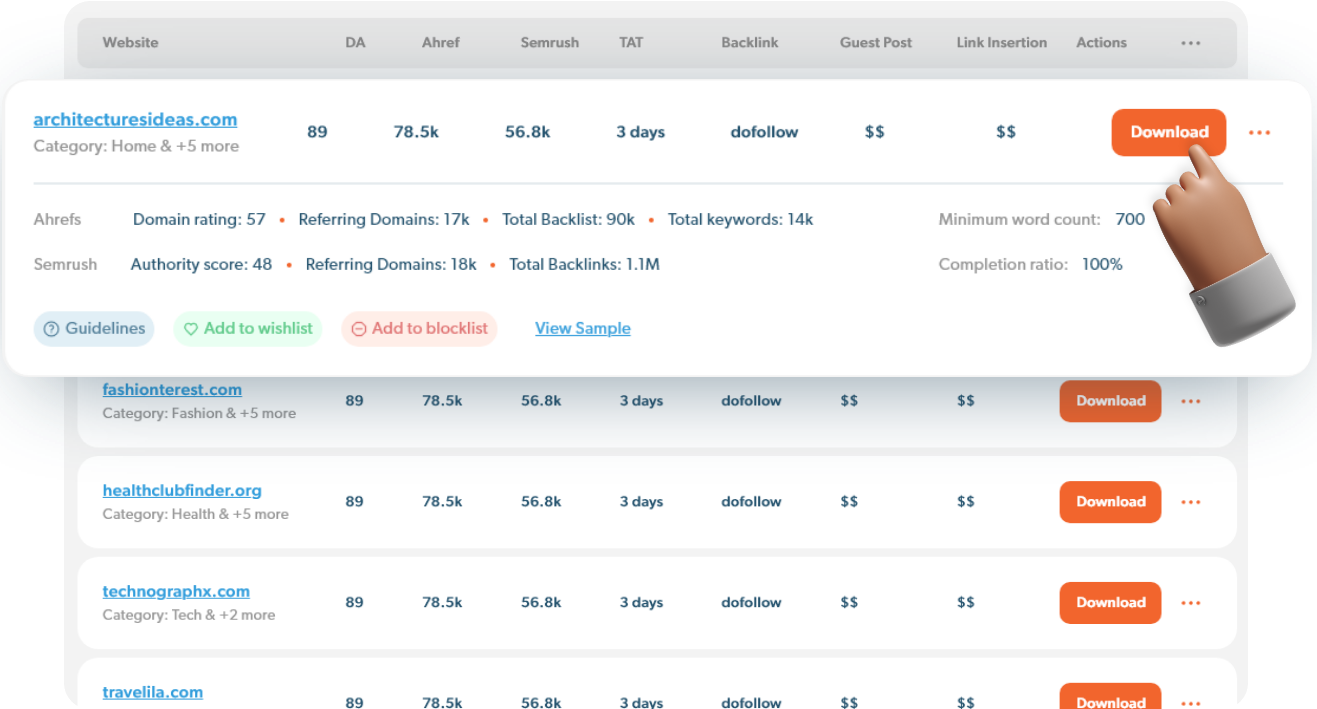With the fitness industry gaining rapid traction, gyms and fitness centers are opening everywhere, making the market highly competitive. Businesses must implement unique strategies to compete with the established players. And that’s when SEO for gyms comes in.
Gym SEO can boost the visibility of your business and bring you both local and online customers. In this blog, we’ll dive deeper into what gym SEO is, why it is necessary, and how you can leverage it to boost your gym or fitness business. By the end, you’ll be equipped with everything you need to take your business to new heights. So, read in full.
What is Gym SEO?
Search engine optimization is the process of optimizing a website for improved ranking in the SERPs (search engine search results). When a website ranks higher in the SERPs, it becomes more visible and drives more organic traffic, leading to better conversions.
This SEO, when performed on a fitness or gym website, is termed fitness or gym SEO. The goal here is to become more visible and increase footfall at the gym or fitness center. Let’s learn more about the importance of gym SEO below.
Why is SEO for Gyms Necessary?
Online search is the first thing people do when they’re looking for something, be it the best eatery or gym nearby. Try performing a simple search using these keywords: “best gyms near me.” You’ll see several Google Business Profiles in the Google search results like these:

The listings appear in the Google search results because the business owners invested in local SEO. You can perform another similar search using the keywords “how to choose the right gym.” Now, you’ll see numerous gym or fitness websites ranking at the top, such as:

These businesses ranked because they optimized their websites for relevant keywords individuals are searching for.
The point we’re trying to make is that by investing in SEO, you can push your business in front of more eyes both globally and locally. When the visibility improves, you can expect more traffic on your website and, thus, more conversions in the form of gym memberships or online sessions.
In a nutshell, SEO for gyms is necessary to become more visible and to get an edge over the competitors in the market.
Top 5 Best Practices for Gym SEO

1. Get Started with Keywords

The first step towards gym search engine optimization is identifying the relevant keywords. Keywords are the words that users search on the internet to find answers to their queries. Examples of short-tail keywords include “best gyms,” “weight training,” “yoga” etc. However, these keywords are too common, vague, and difficult to compete for.
Instead of focusing only on short-tail keywords, you should also invest some time in finding long-term keywords. Examples of long tail keywords include “Best gym membership” and “Personal trainer cost.” Ranking for these keywords is easier as they’re more targeted and relevant. Also, they help you connect with your target audiences better.
Pro Tip: To get started with keyword research, you can opt for popular tools like SEMrush and ahrefs and free tools such as Keyword Planner or Keywords Everywhere.
Two types of keywords you need to focus on include:
Buying Intent-based Keywords
Different customers have different intentions when they’re searching online. When someone has a buying intent, they are actively looking for gym services and ready to buy. Keywords that indicate a buying intent include “HIIT workout in Philadelphia,” “fitness centers in North Carolina” and so on.
When you know what keywords have a buying intent, you can create more relevant content around them. For instance, you can incorporate keywords with buying intent on your service pages. This way, customers who want to buy will land on the relevant page, see relevant content, and take the desired action.
Research Intent-based Keywords
Research intent-based keywords are the ones people use to seek information about gyms, workouts, fitness, and other related things. Common examples include “Best workouts for weight loss,” “how to choose the best gym trainer,” and more.
Users search these keywords to get answers to their queries. While you may not get direct customers by targeting these keywords, your visibility and organic traffic will increase. This can indirectly bring you more customers over time.
2. Create and Promote Engaging & Sharable Content

When it comes to content creation, most gym businesses do that just for the sake of it. They just stuff the keywords without caring about the user and then wonder why they don’t see the results. However, this is your chance to shine and achieve a competitive advantage.
Create highly engaging and informational content (blogs and articles), keeping your ideal customers in mind. Also, include the keywords for SEO, but don’t overdo it.
By striking the right keyword balance and ensuring content quality, you can genuinely help your target audience. This can help you build trust and authority in your niche and generate backlinks as users share your content with their peers.
To get started, you can identify popular keywords and search them on Google. Once you do, you can analyze the content that has already been created and identify what you can do better. This will help you create better content and get an edge over your competitors.
Don’t stop at written content if you really want to improve your SEO for gyms. In this highly competitive space, creating visual content such as high-quality images, infographics, and videos can make a massive difference.
So, in addition to creating written content, also focus on visual content. For starters, you can start including images in your blog posts. If you have some unique aspects to your gym business, such as personal coaching or advanced equipment, you can create dedicated videos to show them off.
Pro Tip: Make sure to avoid stock images and videos as they don’t depict reality. Try to use real people and equipment in your videos or images. This will help your viewers get a real experience, boosting the engagement your content gets.
3. Building Quality Backlinks
One of the most important SEO strategies for gym owners is building quality backlinks. This holds even more importance when your website is new. Building backlinks or link building is the process of getting inbound links from other high-authority websites relevant to your niche.
But why is link-building important? When you get links back from high-domain authority websites, the link juice (authority) travels to your website. This makes your website more credible and trustworthy in the eyes of search engines, improving your ranking in the SERPs.
One of the most effective link-building strategies you can use is guest posting. You can identify high-DA websites in your niche and ask them to publish your post in exchange for a link to your website. Other link-building methods include:
- Niche edits
- Influencer marketing
- Press Releases.
- Gym or fitness communities.
- Podcasts
- PR websites
Pro Tip: An easy and effective way to generate backlinks is by finding a guest post marketplace. A guest post marketplace like Link Publishers can help you buy guest posts and, thus, backlinks. You can choose a high DA option from a pool of 60,000+ websites, upload the content piece, and get backlinks to your site. This method saves you time and resources that you can spend on more productive tasks.
4. Local SEO
Local SEO is extremely crucial for businesses, especially gyms that primarily offer services at their physical facility/location. It’s similar to regular SEO but helps your business appear in the SERPs when someone searches for “local” gyms or fitness centers.
Regular SEO helps you attract visitors to your site from across the globe. While you may get a ton of online business (consultations, personal coaching sessions), your local facility or gym won’t get as much footfall.
So, if you wish to attract local customers near your gym, you need to invest in local SEO.
How to get started with local SEO?

People who want to join a gym perform a simple background check online. This usually encompasses checking the details of your gym or fitness center, such as the name, address, opening hours, reviews, location, phone number, and more. To ensure they see your listing in the local search results, you can work on your GBP.
GBP stands for Google Business Profile. It’s like a digital visiting card for your business. Here’s what a GBP looks like:

If you see the above image, you’ll find all the details a local customer might want. From opening hours, the website link, and the address to reviews and directions, this Google Business Profile has everything.
For your GBP listing to appear like the above, you must create or claim your Google Business Profile. Once you do, make sure to add the necessary details (name, address, phone, services, opening hours, location, website, and more) and get verified.
Don’t forget to upload original images of your gym depicting the equipment quality and the culture your customers can expect. High-resolution images work wonders as customers look at multiple images before deciding. Also, add a decent description of your services and include local keywords for ranking.
Lastly, make sure your existing customers leave reviews on your GBP. The more reviews you have, the more credible and trustworthy your business will come across to the customers.
Pro Tip: You can list your business in other local directories as well for better reach and visibility. However, make sure all the information, especially NAP (name, address, phone), is consistent across platforms. Google loves consistency, and it also shows how professional you are as a business.
5. Optimize Your Website
Whether the customers stay on your website and perform the desired action or bounce off immediately depends on how well-maintained your website is. As you’d obviously want the visors to spend more time on your website, you need to make the necessary optimizations, including:
Mobile Friendliness
Back in the day, mobile friendliness was not a priority. However, now, most users prefer mobile phones, whether it’s booking air tickets, making payments, or looking for a nearby gym. Also, Google checks mobile pages first for the majority of websites. So, make sure your website is mobile-friendly (in terms of design, user-friendliness., UI & UX, etc).
Meta Data
Add a meta title and meta description for each page on your website. This helps Google determine what the page is about. Also, metadata is what the visitors see in the search engine search results. While creating metadata doesn’t guarantee its appearance in the SERPs, the likeliness of this happening improves.
If you create an engaging and keyword-optimized meta title and description, and it appears in the SERPs, your click-through rate can improve. This means you’ll get more organic traffic on your website.
Website Loading Speed
Make sure your website loads pretty fast. Anything more than 3 seconds can push visitors away from your website, leading to a high bounce rate. To improve your website’s loading speed, you can minify the code, optimize images, use a content delivery network (CDN), etc.
Implement Schema Markup:
Schema markup or structured data is the code that helps search engines understand the content on your website better. By implementing schema markup, you can increase the likelihood of getting rich results in the SERPs.
Rich results usually include images, videos, and even ratings in the SERPs. While they don’t directly impact the ranking, they make the search results look more appealing, improving the get click-through rate.
Make sure to know that adding structured data does not guarantee rich results. It’s up to Google if it wants to show your listing as a rich result.
Fresh and High-Quality Content:
Make sure to keep producing high-quality content for all your web pages (service pages, home page, about us page). Also, create a dedicated blog section where you produce informative blogs to help people get answers to their queries. This method can help you engage more visitors and even generate backlinks for you for free.
Wrapping Up
Considering the ever-increasing competition in the fitness industry, SEO for gyms can be monumental for your growth. You can improve your search ranking visibility, generate more organic traffic, and eventually boost your business (increase online business and customer footfall).
So, what are you waiting for? Follow the gym search engine optimization strategies mentioned above and take your business to the next level. However, if you don’t have dedicated resources for managing gym SEO, you can hire a reliable SEO agency like Link Publishers.
With over a decade of experience in helping businesses leverage SEO to supercharge their growth, they can help you make the most of gym SEO. By outsourcing SEO to Link Publishers you can focus on your core operations, while the experts supercharge your gym SEO.
FAQs
What are the best keywords for fitness?
The answer to this question depends on multiple factors such as region, search volume, etc. However, generally speaking, these are some of the best keywords for fitness:
- Fitness classes
- Gym near me
- Personal trainer
- Workout routines
- Health and wellness
- Yoga Studio
- Bodybuilding supplements
How can I Build Backlinks to Improve my Gym’s SEO Authority?
Guest blogging is one of the best methods for building backlinks to boost your gym’s SEO authority. However, you can also try out other methods including
- Niche edits
- Local Partnerships
- Testimonials
- Directory Listings
- Podcasts
- Press Releases
What Metrics Should I track to Measure the Success of my Gym’s SEO Efforts?
Here are the key metrics you can keep an eye on to measure the success of gym SEO:
- Number Of Visitors
- Average Page Views
- Organic Traffic Conversions
- Indexed Pages
- Bounce Rate
- Search Visibility
- Session Duration
- Top Traffic Sources
- Average Time on Page
- Device Used’
- Search Terms
By analyzing these metrics, you can determine if your SEO efforts are headed in the right direction. And if they aren’t, you can take the necessary action to boost performance.







